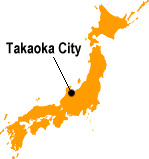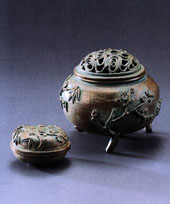

 |
||

|
Leading Copper Metalworking Center that
Has Kept Alive Traditional Techniques
 The history of casting copper alloys in Takaoka, Toyama
Prefecture, is said to date back to the beginning of the 17th century.
After the local feudal government decided to protect and encourage the
local industry, it developed rapidly. Around 1830 they opened up new sales
channels that extended from Edo (present-day Tokyo) to the northern-most
part of the Japanese Archipelago. From the middle of the 19th century production
even expanded to export to overseas markets.
Products from Takaoka include various items for religious use, such as temple bells, as well as items for flower arrangement, ornaments, garden lanterns, tea ceremony utensils, and so forth. Huge bronze statues are also cast in Takaoka. Casting methods include techniques in which the original mold is made in wax or rosin. Such lost-wax casting processes allow the original form to be reproduced as it was created, without loss of detail. The mold is not reusable, so only one reproduction can be made. Moreover, the surface of the cast metal may be ground, engraved or inlaid. The latter involves finishing through a coloring process in which other metals may be added or lacquer applied. Distinctive, sophisticated items can be made using the traditional methods of casting of copper alloys.  Photos: (From top) A temple bell; a garden lantern; an incense burner (Dento Kogei Takaoka Doki Shinko Kyodo Kumiai) Unauthorized reproduction of the
photos in this page is prohibited.
Related Links: |
|

